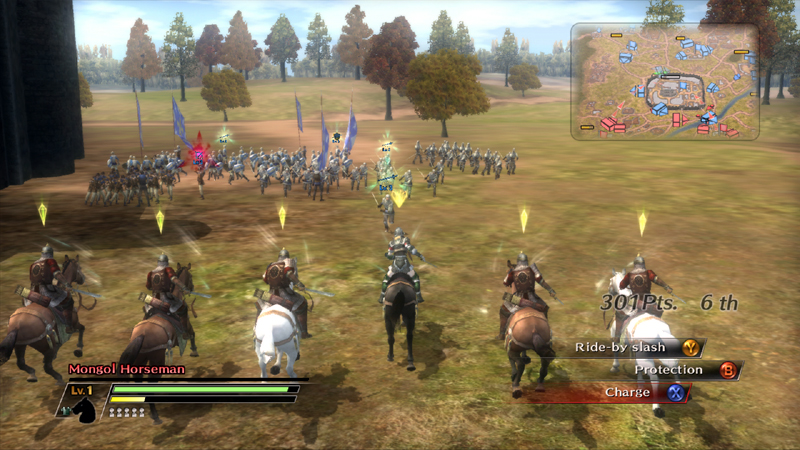Bladestorm: The Hundred Years' War
BY Michael Ubaldi // November 21, 2007
Unsophisticated, but it's got a big heart.
mericans know Koei Company Limited by its predilection for the medieval Orient and mastery in realizing its favorite historical period, in strategic war games, with excellence. Its repertoire includes twenty-year-old franchises Nobunaga's Ambition and Romance of the Three Kingdoms, as well as the more recent Kessen series. For Bladestorm: The Hundred Years' War, Koei chose an acrimonious — yet epochal — time for its introduction to Europe's past.
The Hundred Years' War: King Edward III of England vowed to settle the entanglement of French and English right and claims begun in 1066, when Edward the Confessor retracted his promise of England's throne to William, Duke of Normandy. Hostilities formally opened in 1337 — twelve decades of warfare and strife ensued. The English Channel, the sovereigns' thoroughfare, would be a geographical cordon sanitaire for the next three hundred fifty years. Projectile weapons capable of checking mail and plate armor presaged the rise of ballistics and the decline of heavy cavalry, Welsh longbowmen stultifying French knights first at Crécy in 1346, and conclusively at Agincourt in 1415. The fall of the chevalier rendering feudalism quaint, obligation shifted from fealty to nationalism, encouraged by the passion, trial and martyrdom of Joan of Arc — a woman so preternaturally inspiring that one scanning history does not find another until Carrie A. Nation, when photographic portraiture ruled out any romantic legends.

Infantry may never have worn
great helms, but it's a nice touch.Like the latest Kessen title, Bladestorm is primarily single-player tactical action. France's and England's royalty, the artificial intelligence, administers the war's campaigns. Gameplay involves only two sets of strategic choices — which engagement to participate in, and from which city or fortification to start. As mercenaries, players correspond roughly to nobles, directing single companies on the field. From an interactive menu, "the Tavern," they can select contracts and embark on campaigns, purchase personal equipment and books on martial instruction, familiarize themselves with their contemporaries, and recruit troops. The maximum size of a cohort is derived from the player-character's experience with a given infantry or cavalry type; with numerical favor to footmen, a company can reach nearly three dozen. Soldiers specialize in the materiel of the day: belt-slung weapons, bows, spears, polearms.
Basic combat is straightforward — needing only the directional pad and right shoulder button — but includes button combinations of unit-specific actions and special items; the opportune use of which becomes essential as the game progresses. Players may choose to closely accompany combined, AI-controlled armies as they follow maneuvers — paths designated, on an inset map, as colored arcs that change according to a battle's events. Or, they may move sympathetically but independently. Allied forces are methodical but not always shrewd or expeditious. Players, then, must intervene to complete time-limited campaigns or countervail superior opposition.
Here, temerity is rewarded, Bladestorm's representation of warfare in the high middle ages defined by points of leverage. Koei minimized strategy and its attendant formality. Only a single enemy leader, a "base commander," need be defeated to capture a city or town — as soon as he is found inside the walls and beaten, all nearby enemy units disperse and several allied units appear. The expense to realism is slight, this conjury a justified — and even short-lived — advantage. Players can level inauspicious odds with good timing and judgment: flanking, while allies meet an army head-on, to split the force or surprise the rear guard; circumventing armies altogether, going straight for an objective; intercepting and eliminating stragglers; or drawing off and overpowering defensive companies, exposing a base commander. Koei finely balanced dynamics — players should feel neither superfluous nor burdened, but welcome to risk everything for a swift victory.

The cavalry charge: at the beginning
of its end, but still useful.Even without strategy, Bladestorm might still impose. The manual is dizzying, and should be skimmed; then used only for reference after in-game tutorials are over. Button pathways can be confusing at first, subgroups difficult to distinguish from others; while one's comprehension of the inset map — geographically relative and a little crowded — requires a good, long look at the immediate region. For the historically minded, Bladestorm is bedecked with anachronisms and Japanese embellishments, from a graphic interface more appropriate for Phantasy Star — its button-push chimes constantly interrupting immersion — to flamboyant stylizations in characters' semblance and dress. And gameplay doesn't vary: those to whom this genre doesn't appeal won't like it.
Bladestorm exhilarates even so. Koei's value for histrionics brings players as close as possible to acting out Kenneth Branagh's Henry V or Mel Gibson's Braveheart. When players instruct a contingent to attack, the answer comes in a chorus of enthusiastic shouts. Armies meet in confused, lurching throngs; clangs and yells veritable in every way that warmaking is understood. Music is superb, minor and major keys of oratorio heralding battle and reflecting a day's outcome.
What sophistication was kept from Bladestorm is instead found in — for lack of a better word — heart. There's something, just something, in the experience of the game. Directed by Koei's own solemn interpretation of history and biography, the leaders of men in Bladestorm echo Shakespeare's Exeter: "My soul shall thine keep company to heaven; tarry, sweet soul, for mine, then fly abreast, as in this glorious and well-foughten field, we kept together in our chivalry!"
© 2007 Game and Player. All rights reserved.